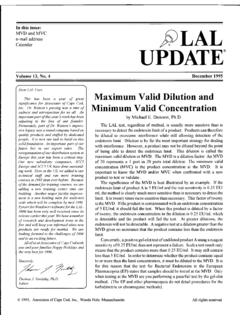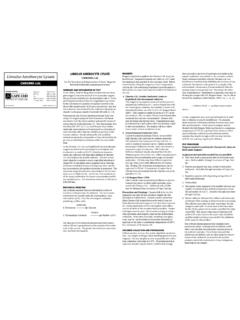Transcription of By Mick Dawson April, 2017 BET White Paper vol.1 no
1 ENDOTOXIN LIMITS. For Parenteral Drug Products By mick Dawson april , 2017 BET White Paper Associates of Cape Cod, Inc., East Falmouth, MA 02536 ~ ~ PR# 17-012. ENDOTOXIN LIMITS. For Parenteral Drug Products _____. april , 2017 BET White Paper Introduction When performing endotoxin testing to determine the acceptability of a product, it is axiomatic that there must be an endotoxin limit above which the product is rejected. Prior to publication in 2012 of the FDA Guidance of Industry: Pyrogen and Endotoxin Testing: Questions and Answers''1, the endotoxin limits used were often those given in the monographs of the United State Pharmacopeia (USP).
2 However, the 2012 Questions and Answers Guidance makes clear that the limits given in pharmacopeial monographs may not account for current product strengths or dosage regimes. It states that endotoxin limits should also be checked using the calculations recommended USP or AAMI standards. In addition, the February 2015. European Pharmacopoeia policy on bacterial endotoxins2 states that most new monographs for parenteral products will not include a requirement for the bacterial endotoxins test (BET) or an endotoxin specification. According to the policy, manufacturers will be responsible for determining whether the endotoxin test is necessary and, if it is, what the endotoxin limit should be.
3 For these reasons, it is more important than ever before to understand how to calculate the endotoxin limit for a particular product. This article discusses limits for parenterally* administered drug products for human adults, for medical devices and for drug product components and excipients. It also addresses the special case of ophthalmic products and makes some suggestions on endotoxin testing of investigational products. It should be noted that the endotoxin limits expressed in most pharmacopeial monographs are written as not to exceed a given endotoxin concentration. This suggests that the limit is less than or equal to the stated concentration.
4 However, the USP <85> Bacterial Endotoxins Test (BET) chapter makes clear that in order to meet the requirements of the test, the material under test must contain less than the endotoxin limit concentration. According to the USP BET chapter, a sample containing a concentration equal to the limit fails the test (as does a concentration that exceeds the limit). Definition of Endotoxin limit The endotoxin limit for a product is the endotoxin concentration that must not be met or exceeded in order to release the product for sale. Per USP chapter <85> Bacterial Endotoxins Test3 (BET), endotoxin limits for different types of parenteral drugs are determined on the basis of dose as follows: Most Parenteral Drugs For parenterals other than radiopharmaceuticals and therapeutics admin- istered on a per square meter of body surface basis the endotoxin limit equation given in the USP is as follows: Endotoxin limit = K/M.
5 Where: K = 5 USP-EU/kg of body weight for any parenteral route of administration other than intrathecal, which is the threshold pyrogenic dose of endotoxin per kg of body weight. (Intrathecally administered products are those administered into the spinal canal so that it reaches the CSF.). K = EU/kg of body weight for intrathecally administered products M = The maximum recommended bolus dose of drug per kg of body weight Note: when the product is to be injected at frequent intervals or infused continuously, M becomes the maximum total dose administered in a single hour period. *Parenterals are products that are not administered enterically --- not via the intestine.
6 They are generally given by injection or infusion. PR# 17-012 Associates of Cape Cod, Inc., East Falmouth, MA, 2. ENDOTOXIN LIMITS. For Parenteral Drug Products _____. april , 2017 BET White Paper Example 1. Calculation of the endotoxin limit for a product to be administered via intramuscular or intravenous injection at a maximum bolus dose of 2. mL/person. Maximum dose per kg (assuming a standard adult human body mass of 70 kg) = 2 mL/70 kg = mL/kg Endotoxin limit = K/M = 5 EU/kg / mL/kg = 175 EU/mL. Example 2. Calculation of the endotoxin limit for a bolus dose of 2 mL/person delivered via intrathecal administration. Maximum dose per kg = mL/kg (as in Example 1).
7 Endotoxin limit = K/M = EU/kg / mL/kg = 7 EU/mL. Example 3. Calculation of the endotoxin limit for a bolus dose by weight where the dose is 10 mg (product) / kg (body weight) and the product concentration is 5. mg/mL. Endotoxin limit = K/M = 5 EU/kg / 10 mg/kg = EU/mg It is often desirable to express the endotoxin limit in EU/mL because these are the units of the endotoxin standards used in endotoxin testing (and, in the case of gel-clot reagents, the units of the reagent sensitivity). In the example above, the concentration is 5 mg/mL, so the conversion of the endotoxin limit to EU/mL is: Endotoxin limit = EU/mg x 5 mg/mL = EU/mL.
8 It is important to note that this limit is of course specific to a product concentration of 5 mg/mL. Radiopharmaceuticals The endotoxin limits of radiopharmaceuticals are calculated differently from those of other parenterals. The USP BET gives specific equations for these products. 1. For products that are not administered intrathecally: Endotoxin limit = 175 EU/V. Where: V is the maximum recommended dose in mL. Although it is not stated in the USP BET chapter, it should be noted that V is the whole body dose; it is not a dose per kg.. The maximum dose is generally that given at (or shortly before) expiration of the product.
9 The radioactivity of the product declines as the isotope decays. Consequently, the maximum dose (volume) is administered at expiration to give the desired radioactive dosage. PR# 17-012 Associates of Cape Cod, Inc., East Falmouth, MA, 3. ENDOTOXIN LIMITS. For Parenteral Drug Products _____. april , 2017 BET White Paper Example 4. Consider a radiopharmaceutical for which the maximum recommended dose is mL: Endotoxin limit = 175 EU/V = 175 mL = 25 EU/mL. 2. For intrathecally administered radiopharmaceuticals Endotoxin limit = 14 EU / V. Formulations administered per square meter of body surface For products with a dose expressed per square meter of body surface (usually anticancer products), in the equation for calculation of endotoxin limits the term K is changed to an amount of endotoxin per square meter.
10 Endotoxin limit = K / M. Where: K = 100 EU/m2. M = the maximum dose/m2. Example 5. Consider a drug for which the maximum recommended dose is 30 mg/m2: Endotoxin limit = K /M = 100 EU/ m2 / 30 mg/m2 = EU/mg Medical Devices USP chapter <161>4 set generic endotoxin limits of 20 EU/device for most devices labeled as non-pyrogenic and EU/device for devices that contact the cerebrospinal fluid (CSF). As an aqueous solution is required for the BET, most medical devices have to be rinsed or extracted to obtain a test solution. The USP chapter gives a formula for the calculating an endotoxin limit specific to the extraction volumes.









